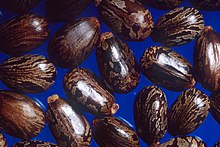Castor wax

Castor wax , also known as partially hydrogenated castor oil , is a hard, brittle vegetable wax .
properties
In the chemical sense, castor wax is a triglyceride and not a wax, i.e. a fatty acid ester of a fatty alcohol. Depending on the degree of hydrogenation, it has a wide melting point range from 60 to 85 ° C. The acid number ranges from 2 to 4, the hydroxyl number is 150, the saponification number is 175 to 185 and the iodine number is approximately 4. The molar mass of the fully hydrogenated oil is 938 g / mol.
Manufacturing
Castor wax is made by hydrogenating castor oil with hydrogen on Raney nickel . Only the double bond of the ricinoleic acid is hydrogenated while retaining the hydroxyl group. The conversion of the hydrogenation can be determined by determining the iodine number.
use
Castor wax is used in polishes, capacitors , carbon paper and mainly as a lubricant . In cosmetics, castor wax is used in skin cleansing agents. The castor wax is converted into fine particles of various grain sizes by spray crystallization. The fine particles have a cleansing and a peeling effect .
Nonionic surfactants can be produced by ethoxylating castor wax with ethylene oxide . Castor wax can be used as an alcohol component in polyurethane chemistry.
Individual evidence
- ↑ Stabilization of substances contained tensides - patent EP1977728 . www.freepatentsonline.com. Retrieved October 27, 2009.
Web links
- Castor Oil a Vital Industrial Raw Material , by DS Ogunniyi
